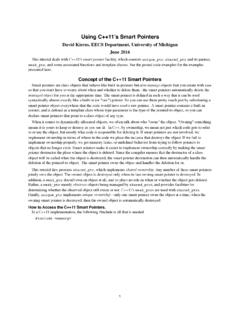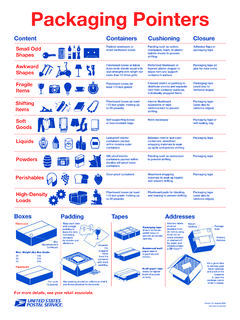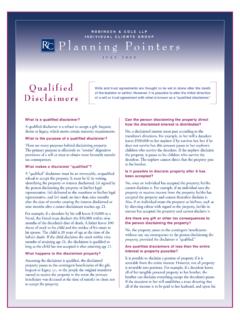Transcription of The Function Pointer Tutorials - newty.de
1 The Function Pointer TutorialsIntroduction to C and C++ Function Pointers, Callbacks and Functorswritten by Lars HaendelJanuary 2005, Bochum, : Have a look at the web page pleaseversion (c) 2000-2005 by Lars Haendel. Permission is granted to copy,distribute and/or modify this document under the terms of the GNU FreeDocumentation License, Version or any later version published by theFree Software Foundation; with no Invariant Sections, with the Front-Cover Text being the text from the title up to the table of contents, andwith no Back-Cover Texts. A copy of the license can be obtained .Be aware that there may be a newer version of this document! for the latest release. If you wantto distribute this document, I suggest you to link to the URL above toprevent spreading of outdated may also download the source code of the examples.
2 The example code is free soft-ware under the terms of the GNU General Public Introduction to Function What is a Function Pointer ? .. Introductory Example or How to Replace aSwitch-Statement .. 22 The Syntax of C and C++ Function Define a Function Pointer .. Calling Convention .. Assign an Address to a Function Pointer .. Comparing Function Pointers .. Calling a Function using a Function Pointer .. How to Pass a Function Pointer as an Argument ? .. How to Return a Function Pointer ? .. How to Use Arrays of Function Pointers ? .. 63 How to Implement Callback functions in C and C++ Introduction to the Concept of Callback functions .. How to Implement a Callback in C ?
3 Example Code of the Usage ofqsort.. How to Implement a Callback to a static C++ Member Function ? .. How to Implement a Callback to a non-static C++ Member Function ? .. 94 Functors to encapsulate C and C++ Function What are Functors ? .. How to Implement Functors ? .. Example of How to Use Functors .. 1211 Introduction to Function PointersFunction Pointers provide some extremely interesting, efficient and elegant programming techniques. You canuse them to replaceswitch/if-statements, to realize your ownlate-bindingor to implementcallbacks. Unfor-tunately probably due to their complicated syntax they are treated quite stepmotherly in most computerbooks and documentations.
4 If at all, they are addressed quite briefly and superficially. They are less error pronethan normal pointers cause you will never allocate or de-allocate memory with them. All you ve got to do isto understand what they are and to learn their syntax. But keep in mind: Always ask yourself if you reallyneed a Function Pointer . It s nice to realize one s own late-binding but to use the existing structures of C++may make your code more readable and clear. One aspect in the case of late-binding is runtime: If you call avirtual Function , your program has got to determine which one has got to be called. It does this using a V-Tablecontaining all the possible functions . This costs some time each call and maybe you can save some time usingfunction pointers instead of virtual functions .
5 Maybe not .. What is a Function Pointer ? Function Pointers are pointers, variables, which point to the address of a Function . You must keep in mind,that a running program gets a certain space in the main-memory. Both, the executable compiled program codeand the used variables, are put inside this memory. Thus a Function in the program code is, like a characterfield, nothing else than an address. It is only important how you, or better your compiler/processor, interpretthe memory a Pointer points Introductory Example or How to Replace aSwitch-StatementWhen you want to call a functionDoIt()at a certain point calledlabelin your program, you just put the callof the functionDoIt()at the pointlabelin your source code.
6 Then you compile your code and every time yourprogram comes up to the pointlabel, your Function is called. Everything is ok. But what can you do, if youdon t know at build-time which Function has got to be called? What do you do, when you want to decide itat runtime? Maybe you want to use a so called Callback- Function or you want to select one Function out of apool of possible functions . However you can also solve the latter problem using aswitch-statement, where youcall the functions just like you want it, in the different branches. But there s still another way: Use a functionpointer! In the following example we regard the task to perform one of the four basic arithmetic task is first solved using aswitch-statement.
7 Then it is shown, how the same can be done using a Introductory Example or How to Replace a Switch-Statement// Task: Perform one of the four basic arithmetic operations specified by the// characters + , - , * or / .// The four arithmetic operations .. one of these functions is selected// at runtime with a swicth or a Function pointerfloat Plus (float a, float b) { return a+b; }float Minus (float a, float b) { return a-b; }float Multiply(float a, float b) { return a*b; }float Divide (float a, float b) { return a/b; }// Solution with a switch-statement - <opCode> specifies which operation to executevoid Switch(float a, float b, char opCode){float result;// execute operationswitch(opCode){case + : result = Plus (a, b); break;case - : result = Minus (a, b); break;case * : result = Multiply (a, b); break;case / : result = Divide (a, b); break; }1 Modern compilers are very good!}
8 With my Borland Compiler the time I was able to save calling a virtual Function whichmultiplies two floats was about 2 s only an example and the task is so easy that I suppose nobody will ever use a Function Pointer for it ;-)2cout << "Switch: 2+5=" << result << endl; // display result}// Solution with a Function Pointer - <pt2 Func> is a Function Pointer and points to// a Function which takes two floats and returns a float. The Function Pointer // "specifies" which operation shall be Switch_With_Function_Pointer(float a, float b, float (*pt2 Func)(float, float)){float result = pt2 Func(a, b); // call using Function pointercout << "Switch replaced by Function Pointer : 2-5="; // display resultcout << result << endl;}// Execute example codevoid Replace_A_Switch(){cout << endl << "Executing Function Replace_A_Switch " << endl;Switch(2, 5, /* + specifies Function Plus to be executed */ + );Switch_With_Function_Pointer(2, 5, /* Pointer to Function Minus */ }Important note:A Function Pointer always points to a Function with a specific signature!
9 Thus all functions ,you want to use with the same Function Pointer , must have thesame parameters and return-type!2 The Syntax of C and C++ Function PointersRegarding their syntax, there are two different types of Function pointers: On the one hand there are pointers toordinary C functions or to static C++ member functions . On the other hand there are pointers tonon-staticC++ member functions . The basic difference is that all pointers to non-static member functions need a hiddenargument: Thethis-pointerto an instance of the class. Always keep in mind: These two types of functionpointers are incompatible with each Define a Function PointerSince a Function Pointer is nothing else than a variable, it must be defined as usual.
10 In the following examplewe define two Function pointers namedpt2 Function ,pt2 Memberandpt2 ConstMember. They point to functions ,which take onefloatand twocharand return anint. In the C++ example it is assumed, that the functions ,our pointers point to, are (non-static) member functions define a Function Pointer and initialize to NULLint (*pt2 Function )(float, char, char) = NULL; // Cint (TMyClass::*pt2 Member)(float, char, char) = NULL; // C++int (TMyClass::*pt2 ConstMember)(float, char, char) const = NULL; // C++ Calling ConventionNormally you don t have to think about a Function s calling convention: The compiler assumescdeclasdefault if you don t specify another convention.






